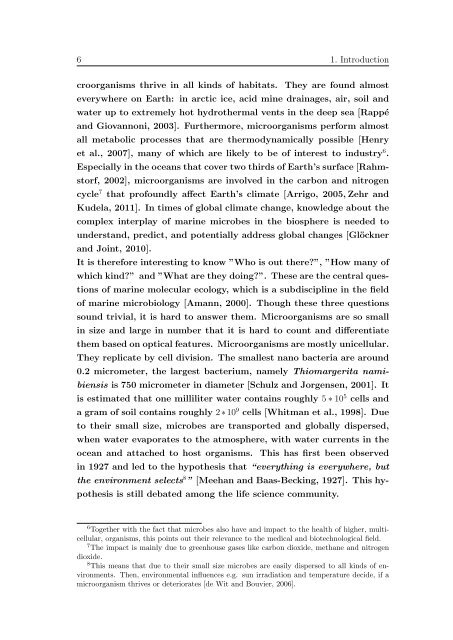Data integration in microbial genomics ... - Jacobs University
Data integration in microbial genomics ... - Jacobs University
Data integration in microbial genomics ... - Jacobs University
You also want an ePaper? Increase the reach of your titles
YUMPU automatically turns print PDFs into web optimized ePapers that Google loves.
6 1. Introduction<br />
croorganisms thrive <strong>in</strong> all k<strong>in</strong>ds of habitats. They are found almost<br />
everywhere on Earth: <strong>in</strong> arctic ice, acid m<strong>in</strong>e dra<strong>in</strong>ages, air, soil and<br />
water up to extremely hot hydrothermal vents <strong>in</strong> the deep sea [Rappé<br />
and Giovannoni, 2003]. Furthermore, microorganisms perform almost<br />
all metabolic processes that are thermodynamically possible [Henry<br />
et al., 2007], many of which are likely to be of <strong>in</strong>terest to <strong>in</strong>dustry 6 .<br />
Especially <strong>in</strong> the oceans that cover two thirds of Earth’s surface [Rahmstorf,<br />
2002], microorganisms are <strong>in</strong>volved <strong>in</strong> the carbon and nitrogen<br />
cycle 7 that profoundly affect Earth’s climate [Arrigo, 2005, Zehr and<br />
Kudela, 2011]. In times of global climate change, knowledge about the<br />
complex <strong>in</strong>terplay of mar<strong>in</strong>e microbes <strong>in</strong> the biosphere is needed to<br />
understand, predict, and potentially address global changes [Glöckner<br />
and Jo<strong>in</strong>t, 2010].<br />
It is therefore <strong>in</strong>terest<strong>in</strong>g to know ”Who is out there?”, ”How many of<br />
which k<strong>in</strong>d?” and ”What are they do<strong>in</strong>g?”. These are the central questions<br />
of mar<strong>in</strong>e molecular ecology, which is a subdiscipl<strong>in</strong>e <strong>in</strong> the field<br />
of mar<strong>in</strong>e microbiology [Amann, 2000]. Though these three questions<br />
sound trivial, it is hard to answer them. Microorganisms are so small<br />
<strong>in</strong> size and large <strong>in</strong> number that it is hard to count and differentiate<br />
them based on optical features. Microorganisms are mostly unicellular.<br />
They replicate by cell division. The smallest nano bacteria are around<br />
0.2 micrometer, the largest bacterium, namely Thiomargerita namibiensis<br />
is 750 micrometer <strong>in</strong> diameter [Schulz and Jorgensen, 2001]. It<br />
is estimated that one milliliter water conta<strong>in</strong>s roughly 5 ∗ 10 5 cells and<br />
a gram of soil conta<strong>in</strong>s roughly 2∗10 9 cells [Whitman et al., 1998]. Due<br />
to their small size, microbes are transported and globally dispersed,<br />
when water evaporates to the atmosphere, with water currents <strong>in</strong> the<br />
ocean and attached to host organisms. This has first been observed<br />
<strong>in</strong> 1927 and led to the hypothesis that “everyth<strong>in</strong>g is everywhere, but<br />
the environment selects 8 ” [Meehan and Baas-Beck<strong>in</strong>g, 1927]. This hypothesis<br />
is still debated among the life science community.<br />
6 Together with the fact that microbes also have and impact to the health of higher, multicellular,<br />
organisms, this po<strong>in</strong>ts out their relevance to the medical and biotechnological field.<br />
7 The impact is ma<strong>in</strong>ly due to greenhouse gases like carbon dioxide, methane and nitrogen<br />
dioxide.<br />
8 This means that due to their small size microbes are easily dispersed to all k<strong>in</strong>ds of environments.<br />
Then, environmental <strong>in</strong>fluences e.g. sun irradiation and temperature decide, if a<br />
microorganism thrives or deteriorates [de Wit and Bouvier, 2006].

















